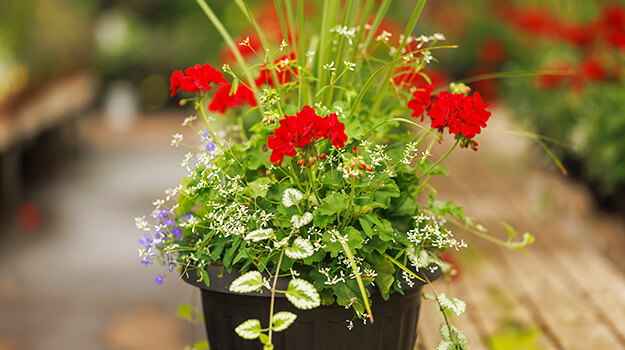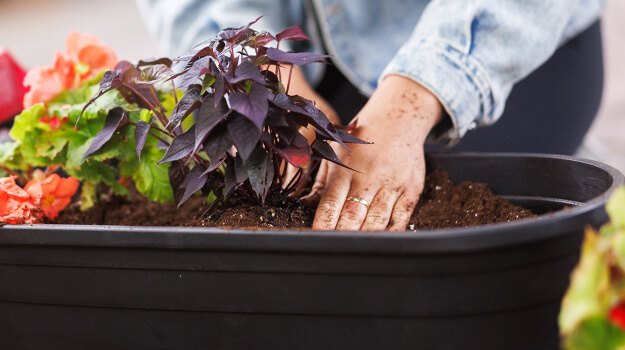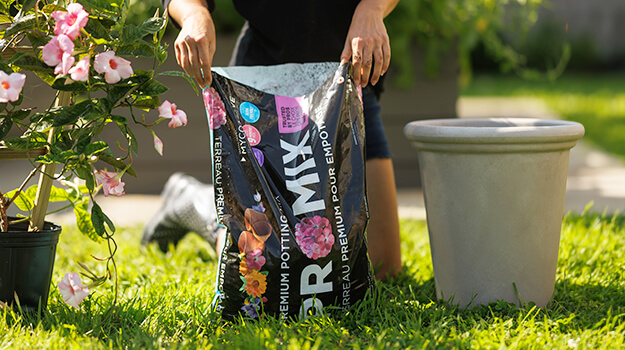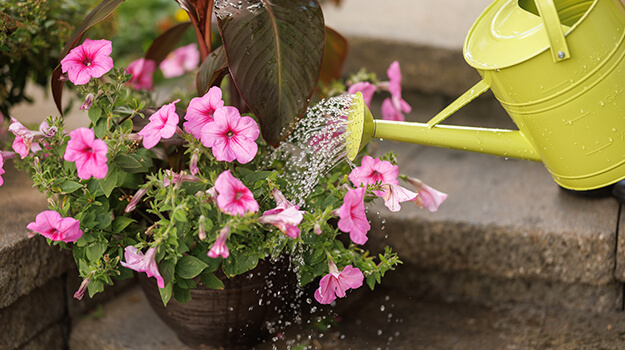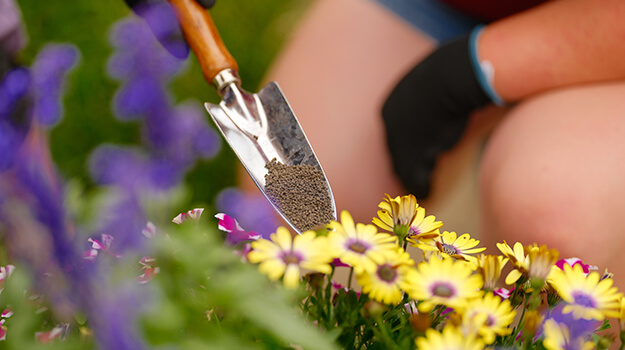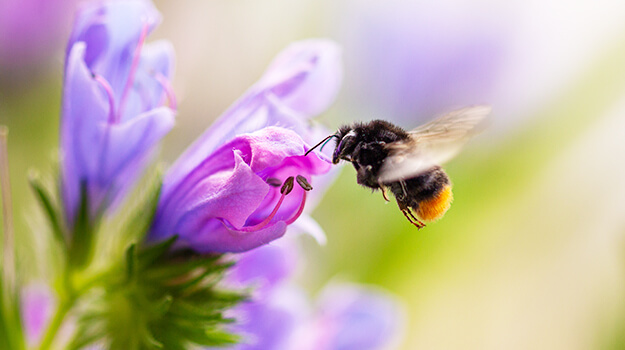Creating a harmonious planter is one thing. Managing to keep it at its peak throughout the season is another. Here's what you need to know to get there.
What is the best container?
Size
Your pot must be adapted to the size of your plants once they are mature. It must for that reason be wide and deep enough to allow plant growth. Planting in too small a container in the spring is a mistake that you’ll quickly regret and that you’ll only make once!
Surprisingly, larger pots generally require less maintenance. The reason is simple: during periods of extreme heat and drought, the soil dries more quickly in a smaller pot. A larger pot contains more water and nutrients. It encourages a well-developed root system. The roots expand more and can draw the water and nutrients down deep, which guarantees more vigorous plants.
Colour
The colour of the container matters too! The water evaporates more quickly in a dark pot. Those dark pots will be better suited to shady locations or plants that require drier conditions, such as lavender and grasses.
Planters are available in a multitude of colours and materials that can both enhance and detract from the aesthetics of your creation. Pottery that is glazed or has painted or embossed patterns should be reserved most of the time for simple compositions. More complex floral arrangements that combine various colours, textures and shapes will be more interesting in a neutral or solid-coloured pot that matches the nuances of the flowers and foliage. So, neon pink, electric blue and apple green may be appealing in the store, but they will almost always disappoint in the garden because they don’t go well with your flower colours.
Drainage
Drainage holes are essential to drain excess water and prevent roots from rotting. Check that there are enough, and that they are of good size. If necessary, make them or enlarge them! If your pots are on a deck or patio, use plant drip trays to capture excess water.
Stability
Finally, make sure that your containers are stable so that the wind does not constantly knock them over. Tall plants, or those with fragile and brittle stems, like dahlias, should be kept sheltered from the wind.
When to plant…climate, hardiness zone and weather
Annuals and plants sensitive to the cold are planted when the risk of frost has passed. The date of the last frost in your area can give you a rough idea, but it is important to check the weather since the temperature is never the same from year to year and it is always possible to get caught off guard by a late frost.
In the event that Mother Nature takes us by surprise, we can store our pots under cover, ideally in an unheated garage or shed. It will be warmer there without the temperature difference being drastic.
Be aware that perennial plants grown in pots are less resistant to the cold. At least two fewer hardiness zones must be calculated. Thus, a hardy perennial in zone 5 will become a hardy plant in zone 3… or less. Hence the importance of putting them in the ground in the fall, with or without their pot, when the temperature drops in a northern climate.
Some plants can also be brought into the house for the winter. Rarely spectacular indoors, coleus and pelargoniums will survive inside to regain their splendour once back in the garden. Others, like begonias, campanulas or cannas, will probably flower your living room if the conditions are favourable for them!
To learn how to make a canna flower indoors in winter, read: Summer bulbs: how to grow them indoors
What soil to use in a planter
If you want your planters to shine all season long, their soil must be of good quality. Select a potting soil specifically formulated for growing in containers. Do not reuse potting soil from the previous year. Your plants have had the entire season to absorb all the available nutrients. You can put this used soil in the compost or in the garden.
Ready to use, the exclusive formula of our PRO-MIX Premium Potting Soil contains, among other things, sphagnum peat moss, coconut fibre, perlite, controlled release fertilizer and mycorrhizae. It ensures good root development to promote water and nutrient absorption. Its composition allows both good drainage in the event of excessive watering and water retention on very hot days. Less watering chores and less risk of root rot!
Do not put stones at the bottom of the pot. In addition to taking up space that your plants need to grow, this practice harms good drainage instead of promoting it. Use a well-balanced potting soil of good quality and in sufficient quantity!
When and how to water a planter
Water whenever necessary! With containers, watering is essential since the roots have limited space to obtain the water and nutrients that are essential to them.
In the summer, a planter in the sun will need to be watered every day, and even twice a day during periods of extreme heat. Water preferably in the morning or evening as soon as the soil is no longer wet. Water during the day if necessary. Some of the water will be lost to evaporation, but it is better to water than to let our plants die!
You should avoid wetting the foliage to limit the risk of fungal diseases and you could use mulch to save work... Mulch can cut watering chores in half!
Also be careful of excess water which is likely to cause the roots to rot. Choosing a good draining potting soil helps, but it is not enough. The bottom of the planters should have drainage holes. If necessary, make them yourselves, add more or enlarge them. Finally, you should not leave water in the saucer under the pots.
When to fertilize your planters
Fertilize your pots on a regular basis. Plants grown in containers generally require more fertilizer because they have access to a limited nutrient reserve and nutrient losses through leaching are higher.
The plants in your containers need to be fertilized more frequently for two reasons: first, because their nutrient reserves are limited by the size of their container, and secondly because the nutrients are washed away during bad weather and watering.
An excellent potting soil with slow-release fertilizer will satisfy less demanding plants such as cosmos, marigolds and nasturtiums. However, without regular fertilizer, plant growth will be less vigorous and flowering less substantial.
Potted plants require frequent watering, and each new addition of water contributes to depleting the soil. The reason is simple: the nutrients present in the soil follow the movement of the water and percolate downwards.
The same phenomenon occurs for plants grown on the ground. However, whenever the soil in the garden begins to dry on the surface, water (and the nutrients with it) is drawn upwards by capillary action. Capillary action ensures that nutrients are ideally found in the area surrounding the roots. Not the same for container growing!
In the case of plants grown in containers, excess water will flow out of the pot through the drainage holes and the nutrients it carries with it will be lost. As planters are watered frequently, repeated washing ends up depleting the soil.
To encourage ideal growth and abundant flowering, plants grown in containers are fertilized once a week until mid-September. Our fertilizers are easy to mix with water, and once applied they allow for the rapid absorption of nutrients by the roots, and you’ll see better results.
PRO TIP: Stop fertilizing during periods of extreme heat or prolonged drought, especially when there is evidence of plant growth stopping. You can resume when temperatures return to normal.
How to promote abundant flowering
Encourage flowering by fertilizing on a regular basis. Deadheading (removing dead flowers by pinching or clipping them off the stem) is also a simple way to encourage new buds to appear, so get your pruning shears out! Fading flowers are not as appealing and direct a lot of energy into seed development if pollinated.
Promote biodiversity
Whether you garden in the ground or in a container, promoting biodiversity brings great benefits, even if your garden is small. Increase the species varieties. Adding a few flower pots will be beneficial for your vegetable plants and your entire garden. For more creativity and effectiveness, combine aromatic herbs… and let them bloom!
Your plants will be less prone to disease and will be more resistant to insect attacks. You will attract more pollinators and your harvest will be more generous. Discover here 20 plants to attract pollinating insects.
Also consult our companion planting guide to know which plants to combine for a winning result.
Seven tips to promote biodiversity in your landscape
- Vary your plantings.
- Provide an abundant and varied food source (flowers, leaves, seeds, nuts and fruits).
- Create places where wildlife can shelter and breed.
- Provide a healthy, accessible and safe source of water (a pond, basin, birdbath or even a saucer containing pebbles on which bees and butterflies can rest).
- Place the right plant in the right place to reduce its water and fertilizer needs.
- Avoid cultivation methods that unbalance the environment (fertilize with organic matter, add mulch).
- Do not collect native plants from the natural environment (harvesting in the wild can lead to the decline of native flora… Buy your plants in nurseries or garden centres!)

